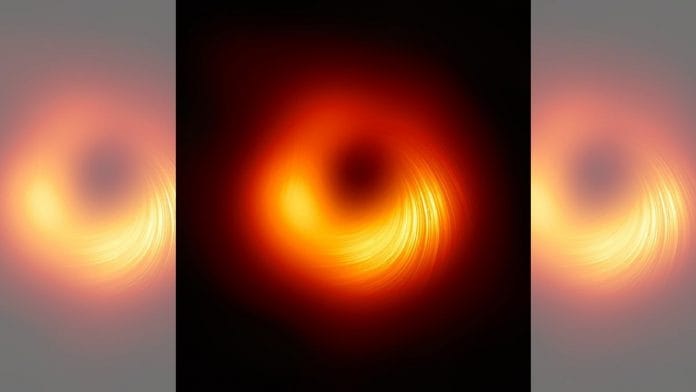Bengaluru: Two years after the first ever image of a black hole was released, astronomers have released a view of the magnetic fields surrounding the same black hole by imaging polarised light around it, about 55 million light years away from us.
The images give us new insights into how the black hole is able to power itself to launch energetic jets of material from its core. The black hole is at the centre of the M87 galaxy, called M87* (M87 star) with about 6.5 billion times the mass of our sun.
The findings were made by over 300 researchers from Africa, Asia, Europe, North and South America, who collaborated on the Event Horizon Telescope (EHT) made up of a consortium of 11 other existing telescopes. The same collaboration imaged the black hole in April 2019.
The results were published in two papers in the journal The Astrophysical Journal this week. A third paper from the findings has been accepted for publication in the same journal as well.
Polarised light carries photons that vibrate on the same plane, and thus the resulting visual is clearer with minimal colour distortion, increased contrast, and reduced glare. Light becomes polarised when it goes through filters, such as those used in sunglasses, or when the light itself is emitted in parts of space where magnetic fields are strong.
Also read: Einstein predicted blackholes in the early 1900s but their weirdness stopped him
What this discovery tells us
Studying how light originating from the region around a black hole gets polarised can provide valuable data about the structure of magnetic fields around the black hole. This in turn helps us understand how powerful black holes consume matter and eject them in the form of energetic jets.
M87*’s relativistic jets, made of energy and matter, extend at least 5,000 light years from its centre, and not much is known or understood about them. They have been observed in multiple wavelengths, including radio, optical, and x-ray. There are parts of the jet that move at speeds greater than 99 per cent the speed of light.
The jets occur owing to the behaviour and effects of matter close to the edge of the black hole and also matter that falls in. However, some bits of matter escape moments before falling into a black hole and are blown out into space in the form of these jets. It is still unclear though how these jets holding more matter than the entire galaxy are launched.
The new observations of polarised light indicates how the magnetic fields behave outside the black hole.
“The observations suggest that the magnetic fields at the black hole’s edge are strong enough to push back on the hot gas and help it resist gravity’s pull. Only the gas that slips through the field can spiral inwards to the event horizon,” said Jason Dexter, assistant professor at the University of Colorado Boulder, US, and coordinator of the EHT Theory Working Group, in a statement.
The observations showed the researchers that among all the models currently in contention to explain the behaviour of matter at the edge of a black hole, only those that have strong magnetised gas surrounding the black hole can explain what they’re now seeing.
“We are now seeing the next crucial piece of evidence to understand how magnetic fields behave around black holes, and how activity in this very compact region of space can drive powerful jets that extend far beyond the galaxy,” said Monika Mościbrodzka, coordinator of the EHT Polarimetry Working Group and assistant professor at Radboud Universiteit in the Netherlands.
Also read: Einstein proved right & a Milky Way secret revealed — why black holes ruled 2020 physics Nobel
The EHT consortium
To observe the highly compact region which is the source of M87*’s jets, and about the width of the solar system, researchers linked multiple telescopes around the world to function as one large Earth-sized telescope, the EHT.
The individual telescopes involved are the ALMA, APEX, the IRAM 30-meter Telescope, the IRAM NOEMA Observatory, the James Clerk Maxwell Telescope (JCMT), the Large Millimeter Telescope (LMT), the Submillimeter Array (SMA), the Submillimeter Telescope (SMT), the South Pole Telescope (SPT), the Kitt Peak Telescope, and the Greenland Telescope (GLT).
Data from these telescopes was processed by two high-performance computers located at the Max Planck Institute for Radioastronomy in Bonn, Germany, and the MIT Haystack Observatory in the US.
The resolution of the imagery is 20 microarc seconds, or the level of detail that is needed from Earth to “measure the length of a credit card on the surface of the Moon”.
The technique used by the telescopes working in conjunction is called very-long-baseline interferometry (VLBI). It synchronises facilities around the world and uses the Earth’s rotation to enable all of them to function together as one large telescope.
(Edited by Manasa Mohan)
Also read: Astrophysicists spot biggest black hole collision so far, and a mystery begins to unfurl






